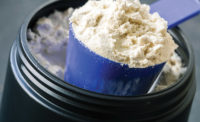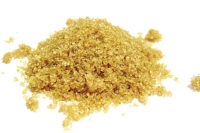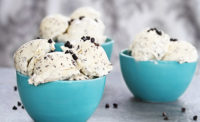Dairy Foods talked to:
Ann Billek, co-owner, Ready Roast Nut Co.
Kim Breedlove, director of R&D, Pecan Deluxe Candy Co.
Diane Douglas, vice president of R&D, Concord Foods Inc.
Kristen Girard, principal food scientist, Ocean Spray Ingredient Technology Group
Kevin Holland, product developer, Tree Top Inc.
John Namy, vice president, sweet applications, Kerry Ingredients & Flavours
Jim Nolte, technology manager, SensoryEffects
John Pimpo, sales manager, Gertrude Hawk Chocolates
Kim Premo, vice president of R&D, Denali Ingredients LLC
Kristy Ruhland, food scientist, QualiTech
Jim Taft, vice president of sales, Star Kay White
Rachel Zemser, food science consultant, California Walnut Board
Inclusions range from baked goods to fruits and nuts to syrupy variegates. They are an easy way for dairy processors to liven up their products. Simple vanilla ice cream becomes a carnival treat by mixing in peanut pieces and caramel swirl. Strawberry low-fat yogurt transforms to a decadent dessert when glazed pecans and shortcake squares become a topping. And pasta becomes a culinary masterpiece when mushroom- and chive-infused butter is melted on top.
Dairy Foods talked with a dozen inclusion suppliers about flavor trends, what’s driving the trends and various formulating tips to assist processors in their “mixing in” endeavors. Here’s what they had to say:
Dairy Foods: Inclusions assist product developers with creating new dairy concepts. What are some of the drivers for the out-of-the box creations that have recently been introduced?
Kim Breedlove: Consumers are the driving force for ice cream manufacturers to be so creative. Today’s consumers have more sophisticated taste buds and demand to be entertained by their food choices. Consumers are privy to more information these days from the internet and food cable TV channels, and thus they have become savvy with trends and what desserts are available in the market. While the tried-and-true flavors like chocolate chip and butter pecan remain, there are consumers who want a restaurant-quality dessert experience from the comfort of their home, which is why you see more delectable choices in the ice cream aisle in your local store.
Rachel Zemser: Out-of-the-box innovations are being driven by consumers who are requesting unique products that they see in other countries or are being imported into the United States. The consumer demand for more innovation leads to developers wanting to be more creative, and suppliers support those efforts by helping the developers come up with ideas that utilize their innovative ingredients.
John Namy: There are many drivers behind why manufacturers are becoming more innovative with their frozen desserts. These drivers are fueled and inspired by food tremors and the culinary landscape. I define a food tremor as a wave that splashes through media outlets such as magazines, television and social media, and channels such as restaurants, grocers and boutique retailers. Tremors are influenced through market data, global culinary travel and social mass media. All of these categories are producing new and innovative product tremors that we can deconstruct and reconstruct into new dessert options that today’s consumer will love.
Kristen Girard: Manufacturers have been investing heavily to reposition ice cream as an all-year-round treat. New formulations are tapping into various consumer trends, such as a desire to experiment with new flavors, waistline-friendly indulgences and on-the-go snacking. Consumers see ice cream as a relatively inexpensive way to indulge and recognize and appreciate quality ingredients. Premium brands are focusing on combining luxurious inclusions with a delicious base flavor. Nut or fruit inclusions provide variance in texture to enhance the eating experience.
John Pimpo: We buy with our eyes, and consumers want to see indulgent goodies in their ice cream.
Kevin Holland: In general, consumers seem to be enjoying foods where unexpected flavors are melded together. Many of these work well in dairy products; for example, strawberry with pepper, pear with ginger and apple with caramel.
Ann Billek: Nuts are familiar inclusions that add crunch and texture to creamy dairy products. Because they come in a variety of sizes and types, it is fairly easy to switch one out and put another into ice cream, with the result being an entirely different product. For example, changing from almonds to cashews gives a chocolate caramel-swirled ice cream a whole new twist.
Dairy Foods: What are some of your company’s most recent inclusion innovations for the various dairy products that can serve as carriers?
Kim Premo: We are always looking at flavor trends in and out of our industry. New inclusions begin with prototype flavors that we screen through our internal tasting teams and we refine these new flavors as we go. This refinement continues until we finalize the flavors that we will offer our dairy partners as potential flavors for their own branded ice cream lines. One example is a new red velvet cake ice cream concept. We looked at data on what was selling in mid- to high-end restaurants and saw that red velvet cake was trending nicely. We took the concept and converted it to an ice cream flavor. We’ve introduced a new line of extruded products: brownie bits, cookie dough pieces, etc., and are getting ready to roll out a line of flakes, chunks and chunks with small inclusions.
Diane Douglas: We recently developed caramel variegates for frozen dessert applications that provide fruity, sweet and savory flavors. These include flavored caramels such as bacon, banana, bourbon, coffee espresso, lemon ginger, raspberry and strawberry.
Jim Nolte: Sweet and salty combinations are hot for ice cream. We’ve developed combinations such as salty caramel variegate with sweet milk chocolate flakes. We combine hot with cold so that the consumer gets a hot sensation from a salsa or pepper-type variegate, which is followed by a cooling sensation from the other ice cream components. Each of these concepts has to be carefully balanced so one component does not overwhelm the other or linger too long.
Pimpo: Our newest ingredients include caramel sea salt truffles, broken peanut butter cups and broken all-natural toffee. The truffles satisfy the sweet/salty profile that consumers are increasingly craving. This inclusion features fleur de sel sea salt, which is the very best sea salt available, and rich decadent caramel. The peanut butter cups are cleanly chopped peanut butter cups without the dust and fines of standard, auger-crushed peanut butter cups. They are all natural and provide a very clean visual in the finished product. The toffee, too, is cleanly cut, with both the center and the coating engineered for ice cream so that the toffee melts quickly with no “stick-in-your-teeth” characteristics like you would encounter with traditional English toffee.
Holland: Our most recent product introduction is fruit clusters. They are made with a high percentage of fruit that is agglomerated with nuts, oats, grains, rice crisps or cracker/cookie-type pieces. The possible combinations are endless. The clusters incorporate the natural goodness of fruit and then build on it through the addition of other nutrient-rich ingredients. These low-moisture inclusions also enhance visual appeal.
Namy: Some of our newest creations have been inspired by the new-found foodie dessert trucks that are roaming our streets. A good example is our blondie brownie, which has a rich creme caramel background with swirls of peanut butter and blondie brownie pieces, or our whoopie cookie pie, which is a whipped cream ice cream packed with chocolate whoopie cookie pieces with swirls of chocolate sauce. We’ve been influenced by celebrity chefs in the restaurant category and have designed a red velvet cheesecake ice cream that has a cheesecake ice cream background blended with real cheesecake pieces and red velvet cake pieces. Our salty caramel toffee is inspired by the namesake innovation that is going on internationally in the confections industry. This ice cream has a brown sugar background that is blended with salty caramel and loads of toffee candy pieces.
Kristy Ruhland: We had a customer trying to put a gum ball in an ice cream novelty bar for a theme park. They were having issues with the gumball being too hard from freezing, which is a choking hazard, as well as kids placing the gum on rides after they were done chewing it. We created an inclusion that tasted like a gumball but didn’t freeze like one. We have several different types of delivery systems that can help customers solve their problems. These delivery systems serve as carriers for functional ingredients, something that yogurt developers find intriguing.
Girard: Sweetened dried cranberries are available in a variety of shapes and sizes and flavor-infused varieties, including mango, pomegranate, strawberry and orange. They can be combined with chocolate or a fruity glaze.
Breedlove: This year we worked on a lot of layered (double/triple) ice cream inclusions. Our facility is designed so we can offer a lot of different products, in many different sizes, and they can all be blended specifically for each customer. The layered inclusions are a result of being able to stack different candy pieces and layer them with chocolates to create a one-of-a-kind piece. This allows our customers to add multiple flavors to their ice cream but they only have to buy one item, thus saving them money as well.
Dairy Foods: What is the value of formulating with nuts and inclusions?
Pimpo: Inclusions give the consumer something to savor just a little bit longer.
Premo: Nuts and inclusions allow you to add flavors and textures to the wonderful, creamy ice cream products that people love. It’s about balancing sweetness and texture for a unique flavor sensation.
Holland: Usage of fruits and nuts can sometimes allow for a health or nutrient content claim. In fact, fruit servings can be claimed if enough fruit is present. We often formulate around a certain serving of fruit and we are able to achieve this using a combination of purées, concentrates and dried products. The amount of a fruit ingredient required to meet a fruit serving varies based on the concentration level. Additionally, a fruit serving can be composed of many fruits combined. We can formulate a strawberry banana yogurt prep that will contain both strawberries and bananas to achieve one fruit serving. “Made with real fruit” is also a fairly common phrase on food labels. Consumers know that fruit is healthy and are looking for products that contain fruit.
Zemser: Cheese pairs well with nuts, and manufacturers are always looking for ways to make things easier for customers. Having nuts in the cheese is one less step that has to be done to get the benefit of both nuts and cheese on the appetizer platter. It should also be mentioned here that the milk of nuts is now being used to make cheese. While some nut milks may be used to make dairy-free cheeses, nut milks can be blended with cows milk to create value-added cheese products with extra protein, fiber, and in the case of walnut milk, omega-3s. Walnuts are the only nuts that provide the plant-based omega-3s known as alpha linolenic acid. Walnuts are naturally free of cholesterol, gluten and sodium, and can help boost protein levels in a finished product.
Girard: Studies over the past three decades have shown that specific compounds in cranberries may help prevent certain harmful bacteria from sticking to healthy cells. This anti-adhesion mechanism suggests that cranberries may have an important role to play in maintaining urinary and gastrointestinal health. A research study found that their anti-adhesion properties are also present in dried cranberries. Consumers are becoming increasingly aware of the links between health and the nutritional value of food.
Dairy Foods: What are some factors to consider when selecting inclusions?
Pimpo: Inclusions coated with chocolate will often keep their integrity longer in ice cream due to the chocolate working as a “varnish” to hold moisture out. In particular, over time, porous inclusions such as pretzels, nuts and cookies will become soft if they are not coated. This will disappoint consumers when they expect a crunch. A soggy cookie or a chewy nut will not make for a repeat buyer. Coating them in chocolate provides the true, inherent quality of the inclusions to be showcased.
Zemser: Crunchy ingredients like walnuts should be coated with something that can provide a barrier between the wet layer and the nut. This can be a sweet layer made with sugar that keeps the nut crunchy. In products like yogurt, many manufacturers use the separate cap pack, which allows the consumer to add a crunchy component right before eating.
Dairy Foods: Looking inside your crystal ball, what types of frozen dessert innovations can consumers expect to see this summer?
Breedlove: The tarot cards are telling us that the following trends will be turning in 2012. Nostalgia is the trend that brings us back to the good times in our life. Flavors that take us back to our childhood or that remind us of “like grandma used to make” are always big trends. Adult beverages in ice cream will be a big trend, such as mojito sherbet and daiquiri flavors with fruits, such as banana and peach. Irish cream flavors will be popular as the trendy consumer wants to top off their dessert with a night cap.
Holland: I think we will see more simplification of ingredient statements and more fruit. Some of the smoothie products in the freezer section are very interesting and I think we will see more of them.
Girard: Manufacturers are experimenting with extreme-flavor frozen desserts, such as mustard or asparagus ice cream. At the same time, there will be a resurgence in well-known and much-loved childhood favorites.
Douglas: Classic desserts and “old is new again” will influence frozen dessert menus. Examples are peanut butter and jelly, whoopie pie, pecan pie and orange cream. Consumers are focused on better-for-you products and are asking for frozen desserts that are all-natural with clean ingredient statements. Greek yogurt is now moving into the frozen dessert market.
Nolte: The two sub-categories that continue to drive frozen dessert innovations are novelties and frozen yogurt, or in some cases, combining them both into a frozen yogurt novelty. From a flavor perspective, the trend continues to be familiar, classic dessert-type recipes being turned into a frozen format. Healthy and all-natural are not going away either, and consumers will continue to seek plain and simple options with clean labels.
Namy: More complex cookie and bar concepts in the freshly baked ice cream categories, along with pie cakes and other bakery fusions, will begin to emerge. Deconstructing salty snacks into ice cream will remain popular. State fair and carnival desserts will cross over into ice cream, as exemplified in cotton candy ice cream.
Zemser: Consumers will see frozen desserts containing more value-added ingredients, those that provide health benefits, such as nuts. For example, crushed walnuts swirled throughout a dairy dessert or as a topping will provide omega-3 fatty acids and fiber.
Ruhland: Ice cream is becoming a decadent dessert with some unusual pairings, such as vanilla ice cream with olive oil and sea salt drizzled over the top.
Jim Taft: I think it is safe to say that the consumer will see more reduced-cost products such as “frozen dairy dessert.” The cost of all food materials has increased dramatically during recent years but the perception is that the consumer will not or cannot pay more. So, the container size shrinks and costly ingredients are removed. This is not just about ice cream, as virtually all processed/packaged foods in this country are continually cost reduced, but just enough so the consumer hopefully does not notice.






